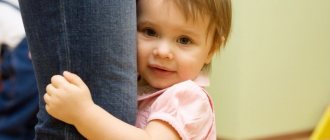Modern preschooler: problems of education and formation of social adaptation
Anna Danilova
Modern preschooler: problems of education and formation of social adaptation
Problems of socialization of modern preschoolers
Modern children live and develop in completely new sociocultural conditions than their peers 25-30 years ago.
Extremely busy parents, a generation gap, technologization of children's subculture, lack of “yard”
socialization , isolation of the child in the family and other trends negatively affect the socialization of modern children .
Today there is no longer any doubt that the modern child is not the same as his peers were several decades ago, and not because the nature of the child himself or the patterns of his development have changed. Life, the subject and social world , the expectations of adults and children, educational models in the family , and pedagogical requirements have fundamentally changed.
How does technological progress affect a child’s psyche? What is a modern child ? The teachers “painted” a portrait of a modern child based on their own observations:
Research data: modern preschooler !
He is developed, inquisitive, smart, erudite, liberated, free, impulsive, capricious, whiny, pugnacious, aggressive, pedagogically neglected, brought up by television .
— Children are well informed . They talk about “adult” topics, watch TV series, understand the intricacies of storylines, remember well everything that happens to the characters and retell the episodes in detail to their grandmothers and mothers. Preschoolers sometimes make such unexpected conclusions and conclusions in non-childish situations that adults begin to seriously think about the premature maturation of modern children .
— Great awareness has a downside. Modern children are by no means ahead of their age in the development of thinking and mental abilities. Moreover, due to health problems, Most 5-year-old children need help from a speech therapist. The modern preschool child speaks a lot (if he speaks, but poorly. Teachers “beat”
anxiety.
The lowest rates of implementation of training and education most often relate to the “Speech development” section. Not only the “Coherent Speech” section suffers, but also the “Dictionary” section. awareness does not lead to an increase in vocabulary.
— Modern children often cannot concentrate on any activity, are absent-minded, and do not show interest. They are in constant, continuous movement, it is difficult to keep them in one place.
Such a diagnosis as ADHD (HYPERACTIVITY)
is already the norm of development.
of information for children (noises, books, TV, gadgets, sounds on the street)
- as a result, there is insufficient neural connections in the children’s brains,
there is no outlet for this flow of information, and therefore this information comes out in modern children through behavioral reactions or children often get sick. Neural connections are also destroyed by the diet of a modern child , foods containing GMOs. Children absorb everything like a sponge until the age of 5; their defense mechanisms are not formed until the age of 5 .
— A child can simultaneously listen to a fairy tale and build with a construction set, and eat.
The younger generation has a “clip consciousness”, fed by advertising and music videos.
— The personal development of children at all times is directly related to the heroes they look up to. But the heroes of books and cartoons in the modern cultural space are sharply different from those beautiful, kind, caring, loving, friendship-valuing, non-aggressive characters that the parents of today's preschoolers and their grandparents grew up with. Most often, the heroes for preschoolers are Western cartoon characters with super powers, who are not always carriers of spiritual values.
“ Modern children’s imagination and creative activity are sharply reduced. Children are focused on getting quick and ready results at the press of one button. Although modern preschoolers are technically savvy, they can easily handle TV, electronic and computer games.
— Educational and useful games and toys are available in every home, so modern children learn to read, write, and count early. Already two-year-old children are buying “ABC”
, hang the alphabet in pictures on the wall.
But in most children, the brain is not mature enough to perceive information and especially a large amount of information , which leads to behavioral reactions, stuttering, and other mental problems .
— For a modern child , especially a resident of a big city, nature is an alien, unknown environment. The natural children's “yard” community has disappeared: children are now less likely to play freely and communicate with peers. The play culture of childhood as the main condition for the development of a child’s personality is distorted.
— A serious problem is caused by the “withdrawal” of role-playing games from the life of a modern child . The computer and television are firmly established in the lives of children, replacing family communication, reading books, grandmother's fairy tales, and conversations with father.
Experimental studies of role-playing games in preschoolers aged 6-7 years have shown that the game does not reach the highest level of development. Consequently, school motivation, generalization, the ability to plan, and build relationships with peers formed The result is a decrease in indicators of readiness for learning in primary school.
— The mental and personal changes of a modern child are influenced by the orientation of society and the restriction of children’s independence by parents. The result is a “rejuvenation” of diseases, increased anxiety and aggressiveness, decreased behavioral control and the development of addictions. There are children who do not want to grow up, studies have shown that this is due to the “inheritance of the experience of family failures,” which occurs as a result of children experiencing parental problems in the family and professional spheres, brought into the child’s everyday life. are with information ; when they come home, they cannot help but think about work, bringing work home.
— The life of children in a metropolis is fraught with enormous risk and parents fear for their safety. According to observations, a small proportion of children of senior preschool age walk in the yard unaccompanied by adults; on one's own; Without the participation of adults, they resolve conflicts in the yard and go to visit friends.
The main problem of the modern preschooler is that socialization , which is vital at this age . As a result, the development of his independence and initiative, arbitrariness, the formation of creative potentials, imagination and fantasy suffers.
That is why the main task of educating preschoolers today is the preservation (and/or revival)
conditions in which the child plays with peers, collaborates with other children in solving various cognitive tasks, shows cognitive initiative, satisfies his own curiosity, develops his own imagination and creative abilities. Where he experiments, fantasizes, discusses, learns to build relationships with people, empathize and find his place in the team, feels cared for and tries to care for others.
Today it is important to provide each child with attention and care for his mental and physical health, and for this, through the joint efforts of the kindergarten and family, it is important to form in children a sense of emotional well-being and psychological comfort, so that he can joyfully and fully live the most difficult and responsible period of his life. life - childhood.
It is “here and now” that the foundations of the personality of the Man of the Future are laid. And if we adults don't realize this, we have nothing to look forward to in the future.
Article
What is the process of socialization of a preschooler ?
Psychological features of socialization of modern preschoolers
Preschool age (from 3 to 7 years)
- This is a period of great change and preparation for a new stage of childhood - schooling.
It is during this period that the processes of all-round development of the child, the introduction of new skills, and the learning of new knowledge actively occur. One of the important stages in the development of modern preschoolers is socialization .
What is the process of socialization of a preschooler ?
The process of socialization of preschool children is the assimilation and acquisition of basic skills of interaction between members of society.
Socialization is necessary primarily in order to prepare a little person for life in a group of people that he will encounter very soon when he goes to school. That is why at this stage it is important not to isolate the child from society, but, on the contrary, to visit children’s groups, playgrounds, kindergarten with him, go to visit friends and invite them to your place.
Socialization is necessary so that the child learns to successfully and easily interact with other people and build relationships.
The term " socialization "
comes from the Latin word socialis - social, which means “the process of assimilation of a certain system of knowledge, norms and cultural values that allow a growing
preschooler to actively and competently participate in the life of society.”
studied the process of socialization of the individual at different stages of the development of society. Among them are S. Freud, J. Piaget, B. G. Ananyev, B. P. Parygin, S. L. Rubinstein, K. A. Albuhanova - Slavskaya, I. S. Kon, D. I. Feldshtein and others.
The main goal of socialization is to establish the foundations of a value-based attitude towards elements of social culture : tolerant – towards people of different nationalities, age and gender values, careful and respectful attitude towards one’s own ethnic values and the heritage of history, humane – towards people, nature, and the surrounding world.
Let's consider the psychological features of socialization of early , middle and senior preschool age .
1. Junior preschool age . In this age period, the child already demands society: he wants to communicate in a group of peers, calls peers by name, adults by patronymic name. Understands who he is (a girl or a boy)
.
Understands the evaluation of good and simple actions. The child enters the children's environment, adapts to it, accepts its norms and rules, and parents actively help with this. They tell the preschooler what to do and what not to do: whether it is worth taking other people’s toys, whether it is good to be greedy, whether it is necessary to share, whether it is possible to offend children, how to be patient and polite, and so on.
And at this age it is normal that a child can be greedy, take other people’s toys, be offended, etc. 2. Middle preschool age . This age period is characterized by the fact that children begin to ask an endless number of questions about everything in the world! A preschooler’s communication becomes brightly emotionally charged and aimed at cognition. Speech becomes the main way of his communication. Difficulties in the child’s behavior and communication with others (stubbornness, obstinacy, conflict, etc.)
are gradually leaving. Takes part in games with clear rules. Ready to share toys and treats. Shows sensitivity to peers and adults.
3. Senior preschool age . The child’s communication takes on a personal form . At this age, children are already interested in questions about the essence of man. A preschooler needs an explanation of many life moments, advice, support and understanding from adults, because an adult is a role model. Looking at adults, they copy their style of communication, relationships with other people, and the characteristics of their behavior. This is the beginning of the formation of your individuality. Expresses his point of view. Able to achieve the final result, to bring the matter to an end. Evaluates his own actions and the actions of his peers. Understands the mood and offers help.
The socialization of a preschool child is a multifaceted phenomenon that occurs under the influence of various factors: society, the family in which the child is raised , and the environment surrounding him.
The influence of the family on the process of socialization of each age stage of a preschooler .
The process of socialization is primarily influenced by the family. Each of its members performs specific social roles , the main ones being parental roles. What they have in common is the desire for the safety of children, care and education .
Both excessive concentration on the child and excessive distance from him have a negative impact on the processes of the child’s psycho-emotional and social development .
The wrong attitude of parents, as well as an overly authoritarian or too liberal parenting can cause various disorders and difficulties with social adaptation .
In preschool age , children surrounded by excessive attentiveness of parents, or raised too freely , as a rule, are infantile and do not know how to establish positive contacts with peers, and their selfish attitude inevitably leads to rejection by the group.
Junior preschool age indicators of socialization
One of the main indicators social maturation is his agreement to let his mother go for a while, and also to remain in the children’s group.
An equally important indicator of the development of social needs is the emergence of interest in other children on the street or in a group. The desire to communicate with other children indicates that the baby is developing his own range of interests.
A child's mastery of basic self-care skills also indicates his readiness to cope without outside help. It is known that socially active children who strive for independence and are not afraid of new life experiences master self-care skills faster.
In the area of social contacts between a child and his brothers and sisters, there are dependencies associated with the child’s birth order and gender.
In such a situation, a feeling of envy awakens, and younger children even exhibit aggressive behavior towards the new family member (they can hit, pinch, take away toys, and even try to throw them out of the stroller).
In 3, 5 and 7 year old children, the severity of negative emotions towards brothers and sisters weakens, and in connection with this, contacts are friendly and positive, while children 4 and 6 years old are more excitable during this period and enter into frequent conflicts with brothers and sisters.
The predominance of negative contacts, as a rule, goes away with age (5-6 years, however, sharp quarrels or destruction of objects that are the property of brothers and sisters, and even fights also occur at the end of the preschool period (6-7)
.
Play and socialization of preschoolers of each age stage.
Children of primary preschool age often spend time playing alone - this is the norm. At 3-4 years old, a child begins to communicate more often and more willingly with peers in order to participate in a common game or productive activity. A three-year-old child is characterized by a position of superiority over his comrades. He can openly express a negative assessment when communicating with a partner ( “You don’t know how to play”
). However, he still needs the support and attention of an adult. Individual communication is optimal in relationships with adults.
At the same time, children of middle preschool age often prefer collective, team forms of entertainment . Children of middle preschool age make their first friends, although such relationships are not yet strong. At 4-5 years old, peers become more attractive and preferred play partners for the child than adults. When resolving conflicts in play, children increasingly try to come to an agreement with their partner, explain their desires, rather than insist on their own.
Children of older preschool age are able to easily take part in team games and recreational activities, which are characterized by the definition of a common goal and action plan. They learn to cooperate, negotiate, and also distribute social roles and rules of behavior associated with certain social situations (shopping, visiting a doctor, traveling)
.
These roles are taken according to gender: girls play feminine roles, and boys play masculine roles.
Independence, self-control, rules of behavior
Children of primary preschool age - learn some norms and rules of behavior associated with certain permissions and prohibitions ( "can"
,
“necessary”
,
“impossible”
, can see the discrepancy between the behavior of another child and the norms and rules of behavior.
However, at the same time, children highlight not a violation of the norm itself, but a violation of the adult’s demands ( “You said that you can’t fight, but he fights”
). It is typical that children of this age do not try to point out to the child himself that he is not acting according to the rules, but complain to an adult.
Children of middle preschool age are still not aware of social norms and rules of behavior, but they are already beginning to develop generalized ideas about how to (should not)
behave.
Therefore, children turn to a peer when he does not adhere to the norms and rules, with the words “they don’t act like that
,
“you can’t do that,”
etc. As a rule, by the age of 5, children, without an adult’s reminder, say hello and goodbye, say
“thank you”
and
“Please”
, do not interrupt the adult, address him politely. In addition, they can, on their own initiative, put away toys, perform simple work duties, and bring the job to the end.
At the same time, in older groups, the development of independence , which should become a distinctive feature of the behavior of a 6-7 year old child. The teacher's attention is directed to the development of initiative, self-organization and self-control. At this age, qualitative changes occur of preschoolers is formed , that is, children begin to make demands on themselves that were previously placed on them by adults.
Compassion and empathy of preschoolers of each age stage.
The norm of social behavior is behavior such as sympathy, assistance, empathy.
As a child develops, the ability to empathize increases. Young children are more likely to empathize with what they understand from their own experience.
Many children of middle preschool age are already able to empathize with both the successes and failures of their peers. So, for example, they are happy when a kindergarten teacher
Children of older preschool age are capable of empathy with faces and figures that have never been encountered in reality, and therefore sympathize with the heroes of fairy tales and films.
Children 6–7 years old have a stable ability to empathize with others. In situations of moral choice, children show a high degree of moral maturity and emotional responsiveness, respond to the suffering of animals, to the experiences of book characters.
Aggression and socialization of preschool children .
Parents and educators observe negative manifestations in children, such as aggression and lack of obedience. Aggression refers to an action that is taken with the intent to harm others. Children show two forms of aggression : instrumental and hostile. Instrumental aggression arises in the desire to achieve something desired: an object, space.
In this case, the child may push another child or hit him - this is the norm for primary preschool age . In turn, aggression is hostile, it is also called “person-oriented aggression”
designed to cause pain to another person, as revenge, as a way of determining dominance.
Instrumental aggression disappears with age, as children learn to behave in society. And person-oriented aggression increases between 4 and 7 years of a child’s life - in middle and older preschool age .
The main signs characterizing social insecurity.
On the verbal level:
• speech is very quiet, slurred, with long pauses, often repeating the same word or, conversely, loud, fast, confused, incoherent;
• tells very little or nothing at all;
• often cannot express his emotional state in words;
• it is difficult to ask to call yourself by name, to call yourself affectionately.
On a non-verbal level:
• decreased motor activity;
• sits quietly, tries not to attract attention;
• often whiny and apathetic;
• facial expressions are either sluggish or express a range of conflicting emotions, often an embarrassed smile;
• cannot make eye contact, does not look at the partner, looks away.
At the level of social contacts :
• not joining a group of children playing;
• various forms of refusal to contact strangers;
• reluctance to part with parents or other close adults;
• reluctance to leave home and communicate with friends;
• inability to assert oneself – put forward specific demands on others to say “no”
, if necessary, express your opinion, critical remark, compromise;
• helplessness, panic in difficult situations.
Targets at the stage of completion of preschool childhood
What should a preschool graduate be like?
• Shows initiative and independence in various activities
• A friendly attitude towards yourself and others, towards the world
• Able to choose one’s occupation and participants in joint activities
• Able to negotiate, empathize with failures and enjoy the successes of others
• The child is capable of volitional efforts, can follow social norms and rules of behavior
• Shows curiosity, asks questions of peers and adults
• Able to set goals, make choices and decisions, evaluate their actions
• Accept different social roles , act in accordance with them and establish relationships with different people
The new task of the preschool educational institution is to organize a friendly society on the territory of the kindergarten to develop social skills in preschoolers . The whole life of a child in a preschool educational institution should be aimed at developing the child’s personality and his interaction with children and adults.
In early preschool age : develop in children a friendly attitude towards loved ones; awaken emotional responsiveness to the state of loved ones, peers, fairy tale characters, etc.; help to master ways of interacting with adults and peers in play and in everyday communication; teach to follow basic rules of behavior; develop the ability to convey different emotional states in games, empathize with the mood of peers; enrich children’s ideas about people (appearance, gender differences, etc., about family.
In middle preschool age : develop in preschoolers the ability to understand the people around them, show a friendly attitude towards them, strive for communication and interaction; expand your understanding of the world around you; learn to navigate the rules and norms of a culture of behavior and communication; develop emotional responsiveness.
In older preschool age : enrich ideas about people, their relationships, emotional and physical states; learn to read
emotions in facial expressions, gestures, intonation;
encourage active manifestation of emotional responsiveness (to have pity, to console, to treat, etc.)
;
cultivate a culture of behavior and communication; deepen ideas about family and family relationships; actively express a kind attitude towards loved ones; introduce forms of greeting , farewell, expression of gratitude, making a request; develop self-control over your actions; deepen your understanding of yourself, your body, personal qualities, capabilities, achievements; develop a sense of self-respect and self-esteem; to direct the consciousness, feelings and actions of children to commit humane and fair actions.
The nervous system and its role in child development
The baby’s nervous system regulates the vital functions of the small organism, ensuring the coordinated functioning of the whole organism. Its main function is the integration and regulation of various processes in connection with changes in the internal and environmental conditions of the baby. The improvement of the nervous system is gradual. In pediatrics, there are different periods. Each of these periods is characterized by its own characteristics. There are certain criteria for the formation of a baby in each period, which make it possible to distinguish between normal and pathological conditions.
Other methods for studying the level of development of young children
It is worth noting that the above-described method of assessing training is screening (quick, superficial). It allows you to examine a large number of children at once. If learning disabilities are identified, the patient needs a more in-depth examination and consultation with specialists such as a neurologist, psychologist, etc.
Along with this technique, in 2006 the World Health Organization proposed the use of the so-called “Windows of Achievement for 6 stages of motor development.” The disadvantage of this technique is that the level of speech formation, emotional and sensory formation of the baby is not taken into account and ignored. There are other methods that allow you to assess psychomotor education. One of the promising foreign methods is the Griffiths Mental Development Scale. Centile graphs, which are quite easy to use, have also become widely used for assessing learning.
What is early child development
Early development is the natural improvement of a child between the ages of 1 and 3 years. This term can be interpreted in another way. For example, when using this term, parents mean the child’s accelerated learning in relation to his peers. We will consider this concept from the point of view of pediatrics. In pediatrics, there is the concept of neuropsychic development, which includes the psychomotor and speech education of the baby. Complex names that are quite easy to understand. These terms are inextricably linked with the early formation of skills and psyche. Therefore, further consideration of the topic will be inextricably linked with these concepts.
Early development is the natural improvement of a child between the ages of 1 and 3 years.




